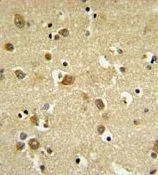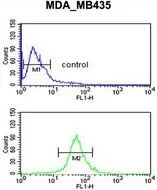
WB analysis of MDA-MB435 cell lysate (35ug/lane) using GTX80429 GABA A Receptor delta antibody, Internal.
GABA A Receptor delta antibody, Internal
GTX80429
ApplicationsFlow Cytometry, Western Blot, ImmunoHistoChemistry, ImmunoHistoChemistry Paraffin
Product group Antibodies
ReactivityHuman, Mouse
TargetGABRD
Overview
- SupplierGeneTex
- Product NameGABA A Receptor delta antibody, Internal
- Delivery Days Customer9
- Application Supplier NoteWB: 1:1000. IHC-P: 1:50-1:100. FACS: 1:10-1:50. *Optimal dilutions/concentrations should be determined by the researcher.Not tested in other applications.
- ApplicationsFlow Cytometry, Western Blot, ImmunoHistoChemistry, ImmunoHistoChemistry Paraffin
- CertificationResearch Use Only
- ClonalityPolyclonal
- ConjugateUnconjugated
- Gene ID2563
- Target nameGABRD
- Target descriptiongamma-aminobutyric acid type A receptor subunit delta
- Target synonymsEIG10, EJM7, GABAARdelta, GEFSP5, gamma-aminobutyric acid receptor subunit delta, GABA(A) receptor subunit delta, GABA(A) receptor, delta, GABA-A receptor, delta polypeptide, GABAAR subunit delta, gamma-aminobutyric acid (GABA) A receptor, delta, gamma-aminobutyric acid type A receptor delta subunit
- HostRabbit
- IsotypeIgG
- Protein IDO14764
- Protein NameGamma-aminobutyric acid receptor subunit delta
- Scientific DescriptionGamma-aminobutyric acid (GABA) is the major inhibitory neurotransmitter in the mammalian brain where it acts at GABA-A receptors, which are ligand-gated chloride channels. Chloride conductance of these channels can be modulated by agents such as benzodiazepines that bind to the GABA-A receptor. The GABA-A receptor is generally pentameric and there are five types of subunits: alpha, beta, gamma, delta, and rho. This gene encodes the delta subunit. Mutations in this gene have been associated with susceptibility to generalized epilepsy with febrile seizures, type 5. Alternatively spliced transcript variants have been described for this gene, but their biological validity has not been determined. [provided by RefSeq, Jul 2008]
- ReactivityHuman, Mouse
- Storage Instruction-20°C or -80°C,2°C to 8°C
- UNSPSC12352203







